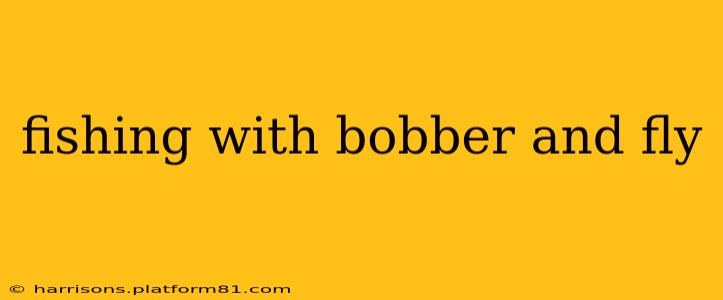Fishing with a bobber and fly offers a unique and effective approach to targeting a variety of fish species. This technique combines the visual appeal and delicate presentation of fly fishing with the accuracy and depth control offered by a bobber. This comprehensive guide will explore the nuances of this technique, helping anglers of all skill levels master this versatile method.
What is Bobber Fishing with a Fly?
Bobber fishing with a fly involves using a bobber (also known as a float) to suspend a fly at a specific depth in the water column. This allows anglers to precisely target fish holding at various depths, from the surface to several feet below. The bobber acts as a visual indicator, signaling strikes through its movement or submersion. Unlike traditional fly fishing where the angler relies on feeling the strike, bobber fishing offers a more visual cue, making it easier for beginners and enhancing the success rate in certain situations.
What Types of Flies Work Best with Bobbers?
The best flies for bobber fishing often depend on the target species and the aquatic environment. However, some general guidelines apply:
- Dry Flies: Useful for surface feeding fish. Smaller dry flies are preferable to avoid dragging the bobber down too much.
- Wet Flies: Ideal for subsurface fishing. They can imitate various aquatic insects or small baitfish.
- Nymphs: Effective for targeting fish that feed on nymphs and larvae in the water column. Their weight can help you reach specific depths.
- Streamers: While less common with bobbers, smaller streamers can work well for targeting aggressive predators.
What Size Bobber Should I Use?
Bobber selection is critical for success. The size and type of bobber will depend on several factors, including:
- Current Conditions: Strong currents require larger, more buoyant bobbers.
- Depth: Deeper water will necessitate bobbers with greater weight capacity and length.
- Fly Weight: Heavier flies will require a more buoyant bobber to keep the fly suspended properly.
- Line Weight: Consider your line weight to ensure proper bobber performance. A bobber that is too small for your line and fly will sink.
Experimentation is key to finding the perfect bobber for your specific fishing conditions.
How Far Should the Fly Be Below the Bobber?
The distance between the fly and the bobber is crucial and depends on the fishing conditions and your target species. Generally:
- Surface Feeding: Keep the fly very close to the bobber's surface, sometimes even just slightly below.
- Subsurface Fishing: Adjust the depth based on the depth of fish you are targeting. Use a longer leader for deeper depths.
Experimenting with various depths is key to discovering where the fish are actively feeding.
What Kind of Rod and Reel Are Best for Bobber and Fly Fishing?
A lightweight spinning rod or a fly rod designed for smaller flies and lighter line will work well. A smooth-dragging spinning reel or a fly reel that can handle lighter lines is also recommended. The rod length should be chosen based on the fishing conditions and casting distance required.
What are the Advantages of Bobber and Fly Fishing?
- Increased Visibility: The bobber provides a clear indication of strikes, making it easier to detect subtle bites.
- Precise Depth Control: You can precisely target fish at specific depths.
- Versatile Technique: This method can be used in various environments and for targeting various species.
- Beginner-Friendly: The visual cues make this a more accessible technique for beginners.
What are Some Common Mistakes to Avoid When Bobber and Fly Fishing?
- Using the Wrong Size Bobber: An improperly sized bobber will either sink or be too buoyant, affecting your presentation and depth control.
- Casting Too Hard: Avoid casting too forcefully, as this can spook fish and lead to tangles.
- Ignoring Subtle Strikes: Pay close attention to any movement of the bobber, even slight dips or tugs, as these might indicate a strike.
- Using Too Heavy a Fly: A fly that is too heavy will pull the bobber under and make it difficult to control the presentation.
By mastering the art of bobber and fly fishing, anglers can open up a new dimension of angling success. Remember to always practice responsible fishing techniques and respect the environment. Tight lines!
